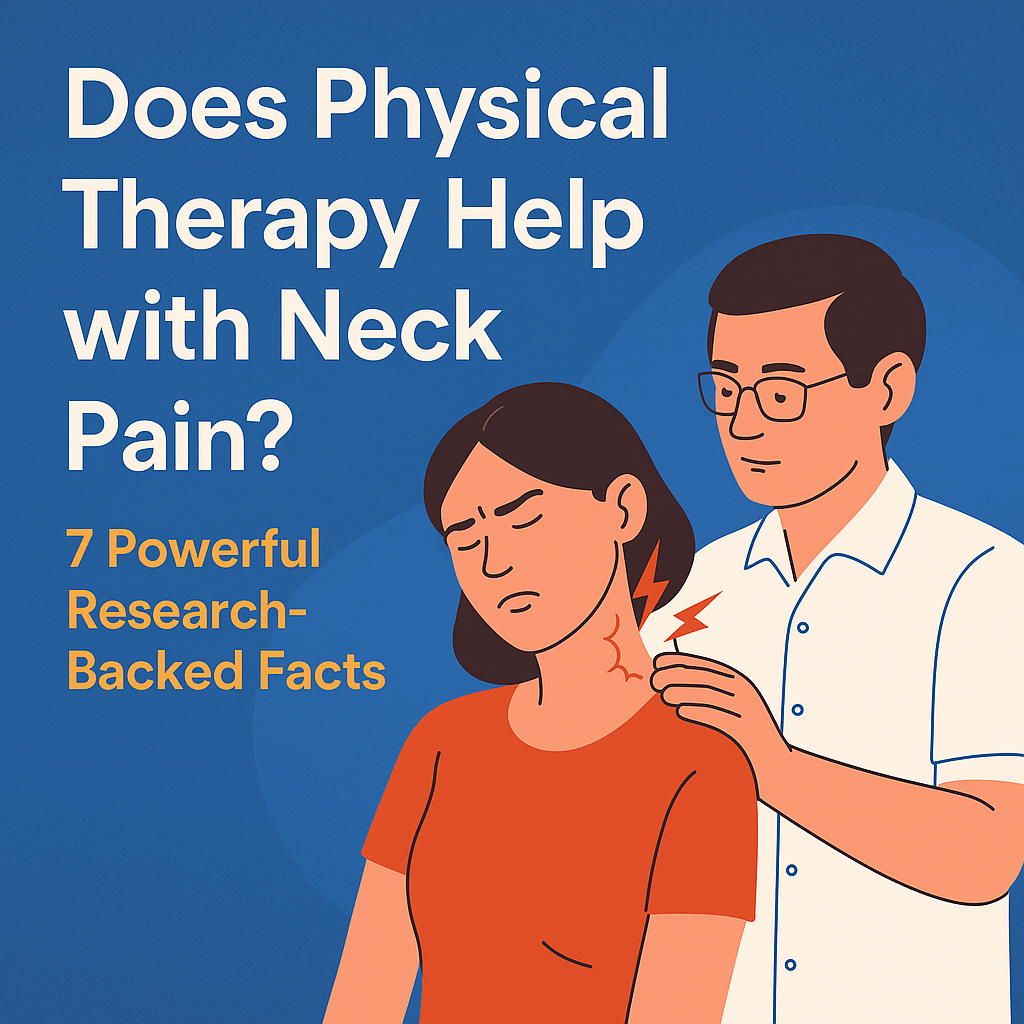
⚠️ Affiliate Disclaimer: This post may contain affiliate links, which means I may earn a small commission — at no extra cost to you — if you make a purchase through one of these links. I only recommend products or services I genuinely trust and believe can provide value. Thank you for supporting My Medical Muse!
Does Physical Therapy Help with Neck Pain? 7 Powerful Facts
Does Physical Therapy Help with Neck Pain? What the Research Says
Neck pain is the kind of problem you don’t really think about, until it’s there. Suddenly, you’re turning your whole body to look behind you when driving, or wincing every time you check your phone and if you’ve ever woken up with that “I must have slept wrong” kind of stiffness, you know just how much it can ruin your day.
Here’s the thing, neck pain is incredibly common. Studies suggest that up to 70% of people will deal with it at some point and according to the World Health Organization, it’s the fourth leading cause of disability worldwide. So, what’s the fix?
If you’ve Googled your symptoms, you’ve probably seen physical therapy pop up again and again as a treatment option but does it really work, or is it just another health trend that sounds good on paper?
Let’s unpack what physical therapy actually is, what the research says, and how to get the most out of it if you decide to give it a try.
Table of Content:
What Is Physical Therapy for Neck Pain?
Common Causes of Neck Pain
How Physical Therapy Works for Neck Pain
What the Research Says
Types of Physical Therapy for Neck Pain
Benefits of Physical Therapy
How Long Before You See Results?
Mistakes to Avoid in Physical Therapy
Risks and Limitations
Self-Care Tips to Complement Physical Therapy
Extra FAQs About Physical Therapy for Neck Pain
When to See a Doctor Immediately
Bottom Line
What Is Physical Therapy for Neck Pain?
Think of physical therapy as coaching for your body, specifically, your neck, shoulders, and upper back. It’s not about just giving you a quick massage and sending you home (although that can be part of it). Physical therapy focuses on fixing the root cause of your pain so it doesn’t keep coming back.
A physical therapist will usually:
- Loosen tight muscles and joints with hands-on techniques
- Teach you targeted exercises to strengthen weak muscles
- Show you how to move and sit in ways that protect your neck
- Give you a custom home program so you can keep improving between sessions
Unlike popping painkillers, which only mask symptoms, physical therapy is about long-term solutions. The idea is to get you moving freely again and keep you that way.
Also Read: Everything You Need To Know About Neck Pain.
Common Causes of Neck Pain
Neck pain can have dozens of triggers, but these are some of the most common ones physical therapists see.
1. Poor Posture (“Tech Neck”):
If you spend hours looking down at your phone or leaning toward your laptop, your head moves forward, putting up to 60 extra pounds of pressure on your neck muscles. Over time, that’s like carrying a small child around with your neck muscles 24/7.
2. Muscle Strain:
Ever wake up with a stiff neck after sleeping in a weird position? Or turn your head too quickly while reversing your car? Those small movements can overstretch muscles and cause inflammation.
3. Whiplash and Injuries:
Car accidents, sports collisions, or falls can whip your head forward and back, injuring ligaments, muscles, and even discs.
4. Wear and Tear:
As we age, our cervical discs (the cushions between neck bones) lose hydration, making them less shock-absorbent and more prone to pain.
5. Pinched Nerves:
When a disc bulges or a bone spur forms, it can press on nerves in the neck. This can cause tingling, weakness, or pain radiating into the arms and hands.
6. Stress Tension:
High stress often shows up in the body and for many people, it lands in the neck and shoulders. Chronic muscle tightening here can keep pain coming back.
How Physical Therapy Works for Neck Pain
A good physical therapist program is custom-tailored, no cookie-cutter routines. Here’s the general flow:
Step 1: Evaluation
- Your physical therapist will check how far you can move your neck in each direction.
- Feel for tight or tender spots
- Assess your posture and how you sit, stand, and move
- Identify muscle imbalances (some too tight, others too weak)
Step 2: Hands-On Work
This can include:
Joint mobilization, gentle movement of neck joints to improve flexibility.
Soft tissue massage, to release tight muscles and improve blood flow. Myofascial release, working on the connective tissue to ease stiffness.
Step 3: Targeted Exercises
Here’s where physical therapy really shines. For example:
- Chin tucks (strengthens deep neck muscles).
- Upper trapezius stretch (releases side neck tension).
- Scapular squeezes (strengthens shoulder blade muscles to support the neck).
Step 4: Education
Your therapist might suggest:
- Raising your monitor to eye level
- Using a small pillow to keep your neck neutral when sleeping
- Taking micro-breaks during long desk sessions
Step 5: Pain-Relief Modalities
These might be used alongside exercise:
- Heat packs to relax muscles
- Ice packs for acute inflammation
- Electrical stimulation (TENS) to interrupt pain signals.
What the Research Says
Acute Neck Pain: A Cochrane Review (2020) found that people with recent neck pain got better short-term relief from a mix of manual therapy and exercise compared to just receiving advice. A 2017 Spine Journal study also found that early physical therapy (within the first 2 weeks) led to quicker pain resolution than waiting it out.
Chronic Neck Pain: A 2018 JOSPT review showed that strengthening neck and shoulder muscles consistently reduced chronic pain levels. Stretching alone wasn’t as effective.
Whiplash Injuries: A 2019 Physical Therapy journal study showed that people who did active rehab (movement and strengthening) recovered faster than those who wore neck collars and rested.
Long-Term Outcomes:
People who kept up their exercises after physical therapy ended had significantly better pain scores a year later compared to those who stopped. The science is pretty clear, physical therapy works best when it combines hands-on therapy, exercise, and patient education.
Types of Physical Therapy for Neck Pain:
- Manual Therapy Massage, joint mobilization, myofascial release
- Exercise Therapy: Strengthening and stretching routines
- Postural Training: How to sit, stand, and move without straining
- Traction: Gentle pulling to relieve pressure on discs and nerves.
- Neuromuscular Re-education: Teaching muscles to fire in the right sequence.
- Pain-Relief Modalities: Heat, cold, ultrasound, electrical stimulation
Benefits of Physical Therapy
- Drug-free relief without side effects
- Improved mobility for daily life
- Better posture to protect your neck long-term
- Lower risk of flare-ups if you stick with exercises
- Confidence knowing how to manage your own neck health.
How Long Before You See Results?
- Mild strain: 1-3 weeks.
- Moderate injury: 4-6 weeks.
- Chronic pain: 2-3 months of consistent therapy.
Some people feel better after just 2-3 sessions, but lasting change usually takes commitment.
Mistakes to Avoid in Physical Therapy
- Skipping home exercises (biggest mistake)
- Doing too much too soon
- Staying in poor posture outside of physical therapy sessions
- Not telling your therapist if something hurts more after a session.
Risks and Limitations
Physical therapist is safe for most people, but:
- You may feel sore after sessions (normal).
- Poor technique can aggravate pain.
- Severe arthritis or advanced disc damage may limit results.
Self-Care Tips to Complement Physical Therapy
- Stretch every hour if you work at a desk.
- Set up your workstation so screens are at eye level.
- Use a supportive pillow that keeps your neck aligned.
- Stay active, light movement prevents stiffness.
- Practice stress management, deep breathing, meditation, or walks.
Extra FAQs About Physical Therapy for Neck Pain
Can physical therapy completely cure neck pain?
- Yes, if it’s due to posture, strain, or mild injury. Degenerative issues may need ongoing care.
Will physical therapy help a pinched nerve?
- Often, yes. Traction and targeted exercises can relieve nerve pressure.
Is physical therapy or chiropractic better?
- physical therapist focuses more on strengthening and long-term prevention, while chiropractic often centers on spinal adjustments. Many combine both.
How many sessions will I need?
- It varies, anywhere from 4 to 12 for mild cases, longer for chronic issues.
Can I just do YouTube exercises?
- Some can help, but without an assessment, you risk doing the wrong moves or worsening your pain.
When to See a Doctor Immediately
- Weakness or numbness in arms or legs.
- Loss of bladder/bowel control.
- Severe headache after neck injury.
- Fever or unexplained weight loss with neck pain.
Bottom Line
Physical therapy isn’t just about fixing today’s neck pain, it’s about preventing tomorrow’s. By combining hands-on care, targeted exercises, and education, physical therapy can restore movement, ease pain, and keep you active for the long haul. If your neck pain has lasted more than a few days or keeps coming back, seeing a physical therapist could be the turning point you need.
⚠️ Affiliate Disclaimer: This post may contain affiliate links, which means I may earn a small commission — at no extra cost to you — if you make a purchase through one of these links. I only recommend products or services I genuinely trust and believe can provide value. Thank you for supporting My Medical Muse!


